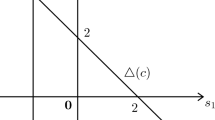Abstract
For every 2-person bargaining problem, the Nash bargaining solution selects a point that is “between” the relative (or normalized) utilitarian point and the relative egalitarian (i.e., Kalai–Smorodinsky) point. Also, it is “between” the (non-normalized) utilitarian and egalitarian points. I improve these bounds. I also derive a new characterization of the Nash solution which combines a bounds property together with strong individual rationality and an axiom which is new to Nash’s bargaining model, the sandwich axiom. The sandwich axiom is a weakening of Nash’s IIA.
Similar content being viewed by others
Notes
S is comprehensive if \(x\in S\) and \(\mathbf{0 }\le y\le x\) implies that \(y\in S\). Vector inequalities: u R v iff \(u_i R v_i\) for both i, for each \(R\in \{>,\ge \}\). Comprehensiveness captures the idea of utility-free disposal.
The function \(l_i\) is a positive linear transformation if \(l_i(t)\equiv \alpha _i t\) for some \(\alpha _i>0\). A pair of such transformations, \(l=(l_1,l_2)\), is also called a rescaling.
The sandwich axiom resembles (but is not identical to) Weak WARP of choice theory; see Manzini and Mariotti (2007). I thank Kemal Yildiz for pointing this out to me.
That each of these three domains satisfies (I) is obvious; \(\mathcal {P}\) satisfies (II) because it contains straight lines and \(\mathcal {C}\) satisfies (II) because it contains rectangles.
However, Theorem 1 extends to this domain by a standard continuity argument.
The LHS is the ratio of payoffs, and the RHS is the ratio of the ideal point’s components.
The compromise on utilitarianism can be viewed as related to the price of fairness associated with the solution \(\sigma \) given the problem S (due to Bertsimas et al. 2011), which is defined as the relative reduction in the utility sum, when compared to the optimal sum: namely, it is given by \(\frac{[U_1(S)+U_2(S)]-[\sigma _1(S)+\sigma _2(S)]}{U_1(S)+U_2(S)}\). Both of these efficiency measures share a similar flavor with the price of anarchy (Koutsoupias and Papadimitriou (1999)), which assigns to each game the ratio of the maximal utility sum over the utility sum in the worst Nash equilibrium. Other related concepts include the price of stability (e.g., Anshelevich et al. 2008) and the price of selfishness (Blocq and Orda 2012).
If \(\sigma (S)=E(S)\) then such an \(\alpha \) may not exist. Here is an example of a smooth problem S for which (i) \(U(S)\ne E(S)\), and (ii) there does not exist an \(\alpha \) such that E(S) maximizes \(\Psi _\alpha \). Consider the problem whose Pareto frontier is \(\{(x,f(x)): x\in [0,1]\}\), where \(f(x)=2\sqrt{1-x^2}\). Assume by contradiction that such an \(\alpha \) exists. Since \(E(S)=(\frac{2}{\sqrt{5}},\frac{2}{\sqrt{5}})\), it follows that \(\Psi _\alpha '(x)\ge 0\) for \(x\le \frac{2}{\sqrt{5}}\) and \(\Psi _\alpha '(x)\le 0\) for \(x\ge \frac{2}{\sqrt{5}}\). The first inequality implies \(\alpha \ge \frac{3}{5}\) and the second implies \(\alpha \le -\frac{5}{3}\)—a contradiction.
\(\alpha <0\) is possible if \(\sigma \) does not respect the EU bounds.
Multiplying the abovementioned objective by \(\frac{1}{2}\) results in a 50–50 average of the utilitarian and egalitarian objectives, hence the name of this solution.
Recall that in Sect. 4 “more utilitarian” meant something else. I trust that no confusion should arise because of this little abuse of terminology.
References
Anbarci, N. (1998). Simple characterizations of the Nash and Kalai/Smorodinsky solutions. Theory and Decision, 45, 255–261.
Anbarci, N. (2002). A simple two-axiom characterization of the Nash solution. Operations Research Spectrum, 24, 215–218.
Anshelevich, E., Dasgupta, A., Kleinberg, J., Tardos, E., Wexler, T., & Roughgarden, T. (2008). The price of stability for network design with fair cost allocation. SIAM Journal on Computing, 38, 1602–1623.
Bertsimas, D., Farias, V., & Trichakis, N. (2011). The price of fairness. Operations Research, 59, 17–31.
Blocq, G., & Orda, A. (2012). How good is bargained routing? In Proceedings of IEEE INFOCOM’2012. Orlando, FL, U.S.A., March.
Cao, X.-R. (1982). Performance functions and bargaining solutions. Proceedings of the 21st IEEE Conference on Decision and Control (pp. 164–171). Orlando, Florida, Dec.
Dhilon, A., & Mertens, J.-F. (1999). Relative utilitarianism. Econometrica, 67, 471–498.
Elster, J., & Roemer, J. E. (Eds.). (1991). Interpersonal comparisons of well-being. Cambridge: Cambridge University Press.
Fleurbaey, M., Salles, M., & Weymark, J. A. (Eds.). (2008). Justice, political liberalism, and utilitarianism: Themes from Harsanyi and Rawls. Cambridge: Cambridge University Press.
Kalai, E. (1977a). Proportional solutions to bargaining situations: Interpersonal utility comparisons. Econometrica, 45, 1623–1630.
Kalai, E. (1977b). Nonsymmetric Nash solutions and replications of 2-person bargaining. International Journal of Game Theory, 6, 129–133.
Kalai, E., & Smorodinsky, M. (1975). Other solution to Nash’s bargaining problem. Econometrica, 43, 513–518.
Koutsoupias, E., & Papadimitriou, C. (1999). Worst-case equilibria. Lecture Notes in Computer Science, 1563, 404–413.
Manzini, P., & Mariotti, M. (2007). Sequentially rationalizable choice. American Economic Review, 97, 1824–1839.
Moulin, H. (1983). Le choix social utilitariste, Ecole Politechnique DP.
Nash, J. F. (1950). The bargaining problem. Econometrica, 18, 155–162.
Pivato, M. (2009). Twofold optimality of the relative utilitarian bargaining solution. Social Choice and Welfare, 32, 79–92.
Rachmilevitch, S. (2014). The Nash solution is more utilitarian than egalitarian. Theory and Decision doi:10.1007/s11238-014-9477-5.
Rawls, J. (1971). A Theory of Justice. Belknap: Belknap Press.
Roth, A. E. (1977). Individual rationality and Nashs solution to the bargaining problem. Mathematics of Operations Research, 2, 64–65.
Segal, U. (2000). Let’s agree that all dictatorships are equally bad. Journal of Political Economy, 108, 569–589.
Sobel, J. (1981). Distortion of utilities and the bargaining problem. Econometrica, 49, 597–619.
Sobel, J. (2001). Manipulation of preferences and relative utilitarianism. Games and Economic Behavior, 37, 196–215.
Acknowledgments
I thank the participants of the microeconomics seminar at Bilkent University, the participants of the T.S. Kim Memorial Seminar at Seoul National University, and the participants of ORSIS 2015 for their helpful comments. Reports from three anonymous referees are also gratefully acknowledged.
Author information
Authors and Affiliations
Corresponding author
Rights and permissions
About this article
Cite this article
Rachmilevitch, S. Egalitarian–utilitarian bounds in Nash’s bargaining problem. Theory Decis 80, 427–442 (2016). https://doi.org/10.1007/s11238-015-9510-3
Published:
Issue Date:
DOI: https://doi.org/10.1007/s11238-015-9510-3




